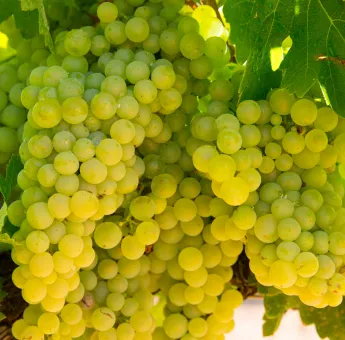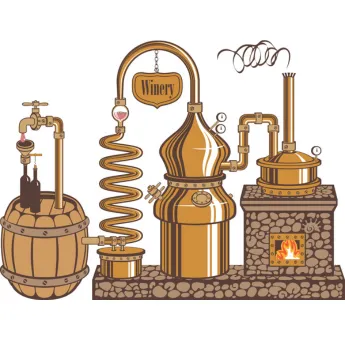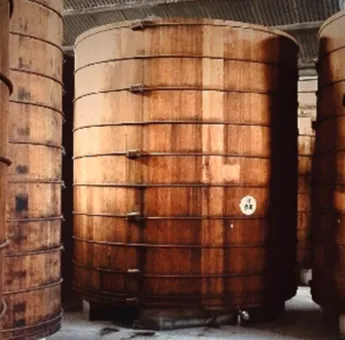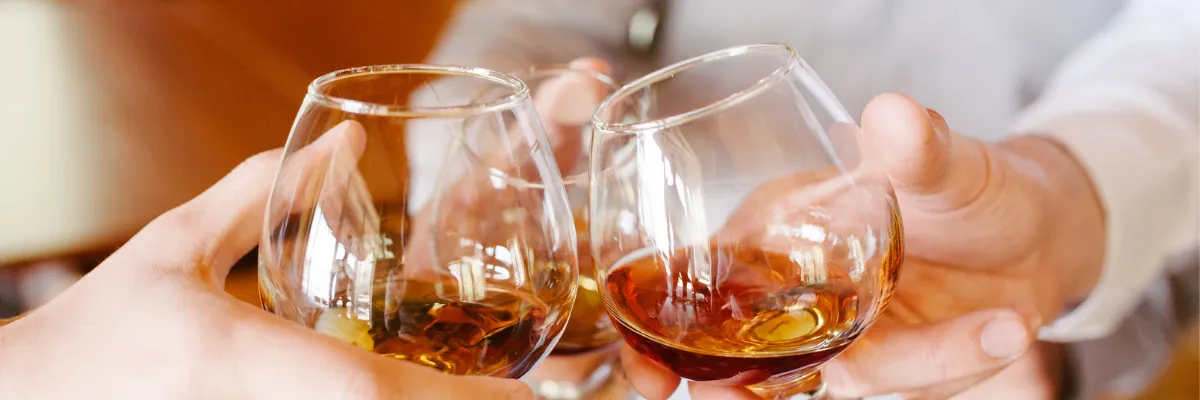Brandy Production
Brandy is produced in three steps: fermentation, distillation, and aging. The process of making brandy typically involves the following steps:

Step 1
The grapes are fermented into wine by introducing yeast to the fruit mash, which converts the natural sugars into alcohol.

Step 2
The wine is distilled into a strong, concentrated alcohol.

Step 3
Brandy is often aged in wood barrels (French and American oak are typical) for 4 to 5 years in cask.
Brandy generally contains 35–60% alcohol by volume (70–120 US proof) and is typically consumed as either a pre-dinner aperitif or an after-dinner digestif. Some brandies are aged in wooden casks. Varieties of wine brandy can be found across the winemaking world. Among the most renowned are Cognac and Armagnac from south-western France as well as most wine producing regions across the globe.
Except for a few major producers, brandy production and consumption tend to have a regional character, and thus production methods significantly vary. Wine brandy is produced from a variety of grape cultivars. A special selection of cultivars, providing distinct aroma and character, is used for high-quality brandies.
Distillation
Brandy is distilled from the base wine in two phases. First, a large part of water and solids is removed from the base, obtaining so-called "low wine", a concentrated wine with 28–30% ABV. In the second stage, low wine is distilled into brandy. The liquid exits the pot still in three phases, referred to as the "heads", "heart", and "tails", respectively. The first part, the "head", has an alcohol concentration of about 83% (166 US proof) and an unpleasant odour. The weak portion on the end, the "tail", is discarded along with the head, and they are generally mixed with another batch of low wine, thereby entering the distillation cycle again. The middle heart fraction, the richest in aromas and flavours, is preserved for later maturation.
Ageing
After distillation, the unaged brandy is placed into oak barrels to mature. Usually, brandies with a natural golden or brown colour are aged in oak casks (single-barrel ageing). Some brandies, particularly those from Spain, are aged using the solera system, where the producer changes the barrel each year. After a period of ageing, which depends on the style, class and legal requirements, the mature brandy is mixed with distilled water to reduce alcohol concentration and bottled.
Age labelling of grades
Brandy has a traditional age grading system, although its use is unregulated outside of Cognac and Armagnac. These indicators can usually be found on the label near the brand name:
V.S. ("very special") or ✯✯✯ (three stars) designates a blend in which the youngest brandy has been stored for at least two years in a cask.
V.S.O.P. ("very superior old pale"), Reserve or ✯✯✯✯✯ (five stars) designates a blend in which the youngest brandy is stored for at least five years in a cask.
XO ("extra old") or Napoléon designates a blend in which the youngest brandy is stored for at least six years.[46]
Hors d'âge ('beyond age') is a designation formally equal to XO for Cognac, but for Armagnac it designates brandy that is at least ten years old. In practice, the term is used by producers to market a high-quality product beyond the official age scale.

Frequently Asked Questions
Your Questions Answered
How can I get started planning my trip with WanderWorld Travel?
Lorem ipsum dolor sit amet, consectetur adipisicing elit. Autem dolore, alias, numquam enim ab voluptate id quam harum ducimus cupiditate similique quisquam et deserunt, recusandae.
What destinations do you specialize in?
Lorem ipsum dolor sit amet, consectetur adipisicing elit. Autem dolore, alias, numquam enim ab voluptate id quam harum ducimus cupiditate similique quisquam et deserunt, recusandae.

Can you assist with travel arrangements for groups?
Lorem ipsum dolor sit amet, consectetur adipisicing elit. Autem dolore, alias, numquam enim ab voluptate id quam harum ducimus cupiditate similique quisquam et deserunt, recusandae.
Are there any safety measures in place during travel?
Lorem ipsum dolor sit amet, consectetur adipisicing elit. Autem dolore, alias, numquam enim ab voluptate id quam harum ducimus cupiditate similique quisquam et deserunt, recusandae.
What type of support do you offer while we're on our trip?
Lorem ipsum dolor sit amet, consectetur adipisicing elit. Autem dolore, alias, numquam enim ab voluptate id quam harum ducimus cupiditate similique quisquam et deserunt, recusandae.
How can I modify my travel plans if needed?
Lorem ipsum dolor sit amet, consectetur adipisicing elit. Autem dolore, alias, numquam enim ab voluptate id quam harum ducimus cupiditate similique quisquam et deserunt, recusandae.